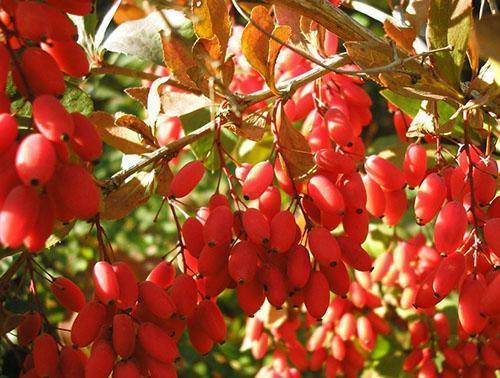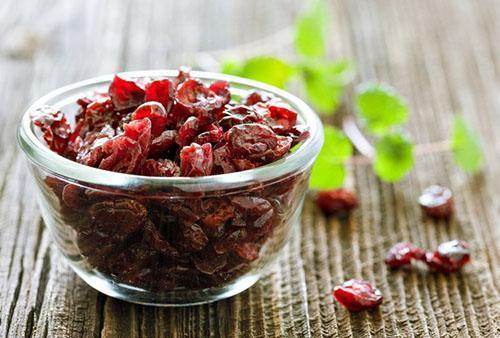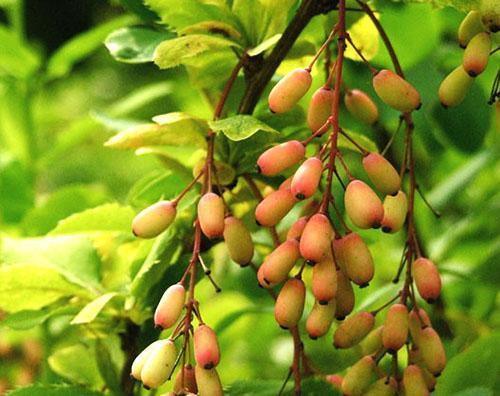Barberry blanks for the winter
 An unpretentious shrub, a native of Asia Minor, barberry today in its wild form is found in the countries of Central and Southern Europe and North Africa, the Middle East and the Caucasus, Afghanistan, Pakistan and India. It was here that the shrub began to grow as a cultivated plant and turned into a source of irreplaceable spice - dried sour berries, which from time immemorial improved the taste of meat dishes and were used to make drinks that quench thirst.
An unpretentious shrub, a native of Asia Minor, barberry today in its wild form is found in the countries of Central and Southern Europe and North Africa, the Middle East and the Caucasus, Afghanistan, Pakistan and India. It was here that the shrub began to grow as a cultivated plant and turned into a source of irreplaceable spice - dried sour berries, which from time immemorial improved the taste of meat dishes and were used to make drinks that quench thirst.
The fruits of barberry, which persist on the branches of the bush from autumn to spring and do not lose their beneficial properties even in the most severe frosts, are reasonably considered in the East a symbol of longevity and endurance.
Since ancient times, Arab and Indian healers have used barberry in the treatment of diseases of internal organs, berries were used as a wound-healing, disinfecting drug. Barberry blanks for the winter fully retain the active substances contained in the berries.
Time of collection and composition of barberry berries
Not only that barberry became a spectacular decoration of garden plots and park areas, its fruits are a godsend for culinary specialists. What can be made from barberry so that its useful qualities can be used in winter?
Fresh berries are used to prepare spicy sauces, marmalades and jams; on the basis of barberry, original liqueurs and liqueurs, jams and seasonings for meat and cereal dishes are obtained.
 After all, it is not for nothing in the East that there is an opinion that pilaf becomes such when purple barberry berries fall into it. The time for picking sour spicy berries comes only in late autumn, when the content of vitamins, minerals and other substances useful to humans becomes maximum. At the same time, it is not worth postponing harvesting, because with the first serious frosts, the fruits soften, and it becomes more difficult to keep them.
After all, it is not for nothing in the East that there is an opinion that pilaf becomes such when purple barberry berries fall into it. The time for picking sour spicy berries comes only in late autumn, when the content of vitamins, minerals and other substances useful to humans becomes maximum. At the same time, it is not worth postponing harvesting, because with the first serious frosts, the fruits soften, and it becomes more difficult to keep them.
How to dry barberry at home?
 The most popular way to harvest barberry for the winter is to dry the fruit. It can be carried out outdoors, in a household oven or in a special dryer for vegetables and fruits. Before drying the barberry, ripe berries after harvesting are sorted out, cleaning from damaged fruits and foreign inclusions, washed and thoroughly dried on clean napkins, and then laid out on sieves, pallets or baking sheets:
The most popular way to harvest barberry for the winter is to dry the fruit. It can be carried out outdoors, in a household oven or in a special dryer for vegetables and fruits. Before drying the barberry, ripe berries after harvesting are sorted out, cleaning from damaged fruits and foreign inclusions, washed and thoroughly dried on clean napkins, and then laid out on sieves, pallets or baking sheets:
- If the barberry is dried in an oven or a special dryer, the plant raw materials at the first stage should not experience heating above 50 ºC. When only the berries stop giving juice, the temperature in the chamber is raised to 60 ºC.
- It is better to cover the barberry that is left to dry in the fresh air with gauze or a fine mesh to protect it from the wind, birds and insects. Do not allow the berries to be in direct sunlight.
During drying, the fruits must be turned up, trying not to damage the berries and not allowing them to stick together.
The end of the process is determined by squeezing a handful of berries in the palm of your hand.If the barberry remains crumbly, does not choke and does not leave traces of juice on the palms, the drying is completed, and the cooled fruits are poured into clean dry containers equipped with tight lids. High-quality dried barberry, as in the photo, can be distinguished by:
- pleasant, cultural smell;
- uniform purple color, without darkening, mold, scorching and dirt;
- glossy dense surface.
Dried berries can be stored for up to a year and serve not only for flavoring food and drinks, but also for health improvement.
Is it possible to prepare barberry for the winter in other ways? Of course, the mass of various preparations will help to replenish the diet in the cold season. An example is a sterilized berry, without any additives or processing. If a clean, dry berry is tightly packed in glass jars, sterilized and closed, the barberry remains practically fresh and can later be used both as a seasoning and for making independent dishes.
Barberry juice, jelly and marmalade
 A concentrate can be made from barberry for making compotes, juice, jelly and fruit drink. For this, the berries, peeled from leaves, twigs and other impurities, are poured with a small amount of water so that it covers a layer of barberry. After that, the container with the fruits is put on fire, brought to a boil and the softened barberry is passed through a press. The resulting juice can be poured into clean containers, sterilized and used during the winter to acidify marinades and sauces.
A concentrate can be made from barberry for making compotes, juice, jelly and fruit drink. For this, the berries, peeled from leaves, twigs and other impurities, are poured with a small amount of water so that it covers a layer of barberry. After that, the container with the fruits is put on fire, brought to a boil and the softened barberry is passed through a press. The resulting juice can be poured into clean containers, sterilized and used during the winter to acidify marinades and sauces.
Interested in what can be made from barberry berries, do not forget that after adding a certain amount of sugar to the concentrated juice, it becomes an excellent basis for jelly, compotes and other drinks. If you put 750 to 1000 grams of sugar on a kilogram of grated berries or juice and boil the composition, the natural pectins in the barberry will turn the cooled mass into marmalade or homemade jelly.
Barberry jam for the winter
 Unlike barberry jelly for the winter and preparations for juice, jam from sour berries of this shrub is not required to grind and press. For 1 kg of berries, take 1.5 kg of sugar and the same amount of water:
Unlike barberry jelly for the winter and preparations for juice, jam from sour berries of this shrub is not required to grind and press. For 1 kg of berries, take 1.5 kg of sugar and the same amount of water:
- The fruits are sorted out and washed, and then poured with water so that the skin softens, and the berries begin to give juice.
- After 8-10 hours, the barberry is poured with sugar syrup and put on a small fire.
- After 30–40 minutes of boiling, the berries become soft, and when the syrup leaves a round drop on the saucer, the jam is removed from the heat, poured into jars and stored in a cool place.
Unusual barberry preparations for the winter: pickles and sauce for meat dishes
 A liter of water and 120–150 grams of salt are used for salting barberry berries per kilogram of fruit. If desired, you can add herbs such as rosemary, basil or oregano to the brine, or you can put such oriental spices as cinnamon, cardamom and pepper in the basil blank for the winter. Clean dried fruits are tightly stacked in jars and poured with chilled brine. After sterilization, the original poultry or game dressing can be kept cold throughout the winter. What else can be made of barberry?
A liter of water and 120–150 grams of salt are used for salting barberry berries per kilogram of fruit. If desired, you can add herbs such as rosemary, basil or oregano to the brine, or you can put such oriental spices as cinnamon, cardamom and pepper in the basil blank for the winter. Clean dried fruits are tightly stacked in jars and poured with chilled brine. After sterilization, the original poultry or game dressing can be kept cold throughout the winter. What else can be made of barberry?
Sour fruit sauce will help gourmets feel like in India or North Africa in their own kitchen. It is a great addition to rice, couscous and roast duck.
 A kilogram of peeled barberry berries will require 250 grams. First, the fruits flooded with water are boiled until softened, ground, freeing from seeds and dense particles of the peel, and then sugar is added to the puree and brought to a boil. Now it's time to add real oriental spices: cloves, grated ginger, cinnamon and ground pepper, as well as other spices of your choice. The sauce is removed from the heat when it becomes thicker, but does not lose its initially bright color and aroma. After pouring the product into glass containers, the sauce must be sterilized and closed.
A kilogram of peeled barberry berries will require 250 grams. First, the fruits flooded with water are boiled until softened, ground, freeing from seeds and dense particles of the peel, and then sugar is added to the puree and brought to a boil. Now it's time to add real oriental spices: cloves, grated ginger, cinnamon and ground pepper, as well as other spices of your choice. The sauce is removed from the heat when it becomes thicker, but does not lose its initially bright color and aroma. After pouring the product into glass containers, the sauce must be sterilized and closed.
Alcohol and wine tinctures are also prepared on the basis of barberry.
 But not only berries are beneficial. This amazing plant also has useful roots and leaves, therefore, such raw materials from barberry are worthy of being prepared for the winter.
But not only berries are beneficial. This amazing plant also has useful roots and leaves, therefore, such raw materials from barberry are worthy of being prepared for the winter.
Harvesting for the winter of barberry leaves and rhizomes
 The leaves, in addition to almost all the components found in the fruits of barberry, are rich in essential oils and resinous substances. In folk medicine, the roots of the bush, and even the bark of the barberry, are also used. What can be made from barberry leaves? Such raw materials are dried to be used during pickling during the summer and autumn. cucumbers, squash and tomatoes. Together with dried berries, the chopped leaves can be added as a seasoning to baked meat.
The leaves, in addition to almost all the components found in the fruits of barberry, are rich in essential oils and resinous substances. In folk medicine, the roots of the bush, and even the bark of the barberry, are also used. What can be made from barberry leaves? Such raw materials are dried to be used during pickling during the summer and autumn. cucumbers, squash and tomatoes. Together with dried berries, the chopped leaves can be added as a seasoning to baked meat.
 But if the time for picking berries is in the middle or second half of autumn, then the leaves accumulate the greatest amount of valuable substances in May or June. The best raw materials are young shoots, about 10 cm long, and foliage on them. How to dry barberry leaves in a dryer and oven? The collected raw materials are washed, dried, soaked with a napkin, and laid out in a thin layer on baking sheets. During oven drying, the temperature should not exceed 45-50 ºC.
But if the time for picking berries is in the middle or second half of autumn, then the leaves accumulate the greatest amount of valuable substances in May or June. The best raw materials are young shoots, about 10 cm long, and foliage on them. How to dry barberry leaves in a dryer and oven? The collected raw materials are washed, dried, soaked with a napkin, and laid out in a thin layer on baking sheets. During oven drying, the temperature should not exceed 45-50 ºC.
If the barberry is harvested correctly for the winter, the leaves, roots and fruits do not darken and retain all the useful properties.
It is more convenient to dry the leaves in the fresh air in small bunches, covered with gauze and located in a ventilated place, protected from sunlight. In such conditions, the raw material spends 5-7 days, after which the leaves are ready for use and storage in paper bags or glass sealed containers. Similarly, the roots of barberry are dried, harvested for the winter in late autumn and taken from adult bushes, which can tolerate the loss of a small part of the root system. Raw materials are cleaned of soil, damaged areas and small, filamentous rhizomes, and then dried. A quality product used for medicinal purposes should be light yellow or cream on the cut.
